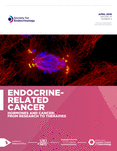Animal models of medullary thyroid cancer: state of the art and view to the future
- Giovanni Vitale1,2⇑,
- Germano Gaudenzi1,
- Luisa Circelli3,
- Marco F Manzoni4,
- Andrea Bassi5,
- Niccolò Fioritti6,
- Antongiulio Faggiano7,
- Annamaria Colao8,
- on behalf of NIKE Group
- 1Department of Clinical Sciences and Community Health (DISCCO), University of Milan, Milan, Italy
- 2Laboratory of Endocrine and Metabolic Research, Istituto Auxologico Italiano IRCCS, Milan, Italy
- 3Department of Experimental Oncology, Laboratory of Molecular Biology and Viral Oncology, Istituto Nazionale per lo Studio e la Cura dei Tumori, ‘Fondazione Pascale’ – IRCCS, Naples, Italy
- 4Department of Endocrinology and Internal Medicine, Endocrine Tumors Unit, San Raffaele Hospital Vita-Salute San Raffaele University, Milan, Italy
- 5Department of Physics, Politecnico di Milano, Milan, Italy
- 6Department of Biosciences, University of Milan, Milan, Italy
- 7Thyroid and Parathyroid Surgery Unit, Istituto Nazionale per lo Studio e la Cura dei Tumori ‘Fondazione G. Pascale’ – IRCCS, Naples, Italy
- 8Department of Clinical Medicine and Surgery, Section of Endocrinology, ‘Federico II’ University of Naples, Naples, Italy
- Correspondence should be addressed to G Vitale; Email: giovanni.vitale{at}unimi.it
Abstract
Medullary thyroid carcinoma is a neuroendocrine tumour originating from parafollicular C cells accounting for 5–10% of thyroid cancers. Increased understanding of disease-specific molecular targets of therapy has led to the regulatory approval of two drugs (vandetanib and cabozantinib) for the treatment of medullary thyroid carcinoma. These drugs increase progression-free survival; however, they are often poorly tolerated and most treatment responses are transient. Animal models are indispensable tools for investigating the pathogenesis, mechanisms for tumour invasion and metastasis and new therapeutic approaches for cancer. Unfortunately, only few models are available for medullary thyroid carcinoma. This review provides an overview of the state of the art of animal models in medullary thyroid carcinoma and highlights future developments in this field, with the aim of addressing salient features and clinical relevance.
- medullary thyroid cancer
- animal models
- mice
- zebrafish
- Drosophila melanogaster
- chick chorioallantoic membrane
- Received 18 October 2016
- Accepted 24 October 2016
- Made available online as an Accepted Preprint 31 October 2016
- © 2017 Society for Endocrinology












